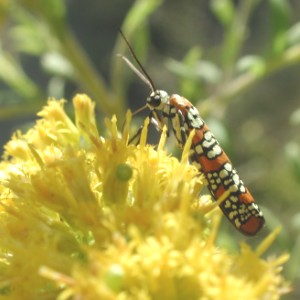Ailanthus webworm
|
|
| Ailanthus webworm | ||||||||||||||||
|---|---|---|---|---|---|---|---|---|---|---|---|---|---|---|---|---|
 | ||||||||||||||||
| Scientific classification | ||||||||||||||||
| ||||||||||||||||
| Binomial name | ||||||||||||||||
| Atteva punctella Cramer, 1781 |
The Ailanthus webworm, Atteva punctella, is an ermine moth now found commonly in the United States.
There is some uncertainty about the origin of the Ailanthus webworm, but it is thought to be native to South Florida and the American tropics, with the original larval host plant, the Paradise Tree (Simarouba glauca). Tree-of-Heaven (Ailanthus altissima), a tree originally from China, has been widely introduced and Atteva punctella has jumped to this new host plant (giving it its common name, Ailanthus webworm). The moth does not survive cold winters, but migrates north each year so it is commonly seen in summer throughout the continental US, and occasionally eastern Canada.
Larvae produce nests on the host plant by pulling two to three leaflets around a network of loose webbing. Then they consume the leaflets. The caterpillars have a wide, light greenish-brown stripe down their backs and several thin, alternating white and olive-green stripes along their sides. The adult moth visits flowers and is a pollinator.
Ailanthus is considered an invasive species by some, although it is still sold by nurseries as yard plant, mainly because it will grow in polluted or otherwise difficult places. Atteva punctella can be a minor pest in nurseries, although it rarely does serious damage.
